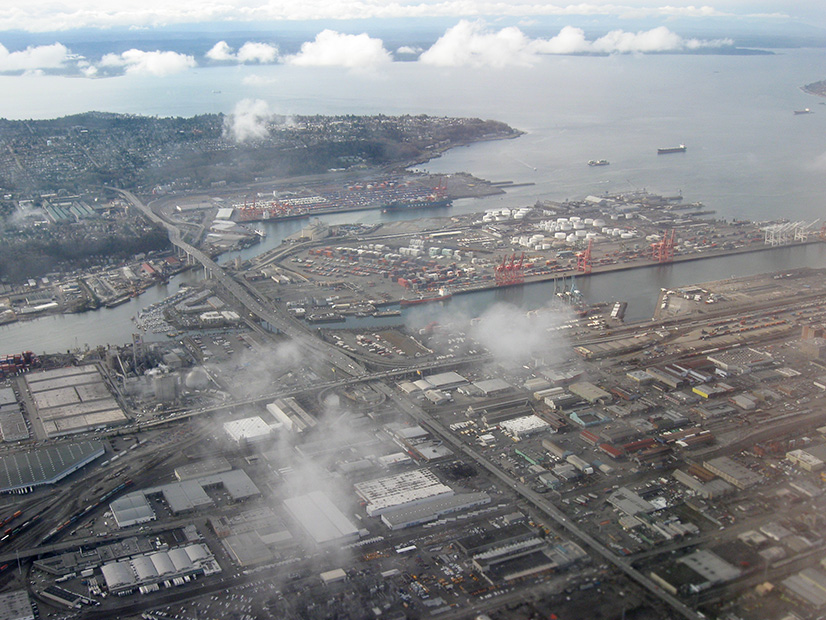
Initial prices for Washington cap-and-trade emissions allowances will depend on whether the state joins with the California and Quebec emissions trading system, according to economic analysis released Friday.
North America will soon have two cap-and-trade systems: the existing Western Climate Initiative (WCI) serving California and Quebec and another scheduled to go online on Jan. 1, 2023, in Washington.
Washington’s legislature passed a cap-and-trade law in 2021, ordering the state’s Department of Ecology to map out the regulations in 2022. Final regulations are expected to be adopted late this year. (See Cap-and-trade Project to Provide Wash. $500M Annually.)
Under the program, the Ecology Department will auction a still undetermined number of emissions allowances four times a year to smokestack industries. The first two auctions are scheduled for the first half of 2023, and the state will set the number of emissions allowances 60 days prior to the auctions.
Companies would bid on the allowances in clusters of 1,000 individual allowances. The number of allowances will be decreased over time to meet 2035 and 2050 decarbonization goals. Companies will be allowed to buy, sell and trade those allowances. If Washington chooses to join the WCI, it will expand its purchase and trading territory to those two areas.
For each auction, a specific number of allowances would be made available to bidders. All bids must be above a certain price level set in advance by the state.
The highest bidder would get first crack at the limited number of allowances, while the second highest bidder would get second crack, followed by additional iterations. The auction ends when the last of the designated number of allowances is bid upon. Then all the successful bidders pay the same clearing price set by the lowest successful bid. Bidding companies are limited to acquiring 4% to 10% of the total number of allowances, depending on various criteria.
Washington retained McKinsey & Co. subsidiary Vivid Economics to perform the pricing study, which examines three scenarios.
In the first, “linking” scenario, Washington joins the WCI by 2025.
In the second, “frontloading” scenario, Washington goes solo with a system in which Allowance Price Containment Reserve (APCR) allowances for 2023-2030 are placed into the APCR at the beginning for 2023. The APCR is designed to act as a safety reserve from which additional allowances can be sold if allowance prices rise quickly enough to potentially cause an economic shock.
The study’s third scenario has Washington going solo without linking to the WCI or frontloading the APCR.
In examining the “linking” scenario, Vivid found it more complicated to estimate prices than for the solo effort because the California-Quebec cap-and-trade market is five time the size of Washington’s and would be the dominating market force in setting auction prices. Vivid said more analysis is needed to get a good grasp on floor prices with Washington, California and Quebec sharing the same program. The report anticipates that if a link-up occurs, Washington’s floor price would be $41 per metric ton (MT) in 2023.
In the “frontloading” scenario, Vivid calculated that the allowance floor price would be $58/MT beginning in 2023, $64/MT from later in 2023 to 2027, and $89 per metric ton from later in 2027 to 2030.
In the third scenario, Vivid estimates allowances would cost $68/MT in 2023, $71/MT from later in 2023 to 2027, and $89/MT from later 2027 to 2030.
A 2021 Washington Department of Ecology report put the state’s carbon dioxide emissions at 99.57 million metric tons in 2018. The report shows that from 2016 to 2018 the transportation sector was the largest contributor at nearly 45% of emissions, followed by industry (19%), electricity consumption (17%) and agriculture (7%). A 2008 law calls for overall emissions to be reduced to 50 million MT by 2030, 27 million MT by 2040 and 5 million MT by 2050.
The Vivid report said that roughly 68 million MT of Washington’s carbon emissions current fall under the cap-and-trade law’s jurisdiction.

